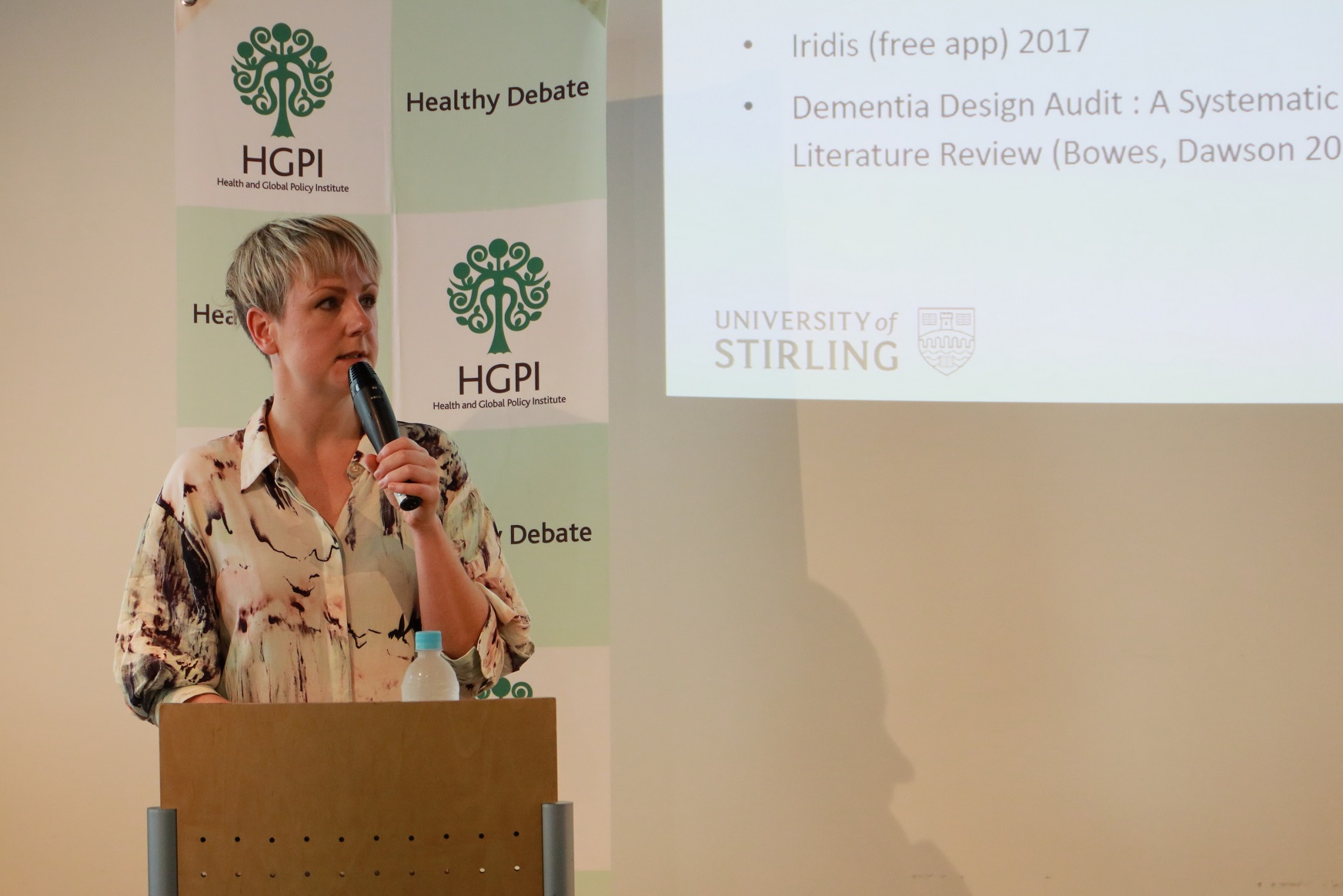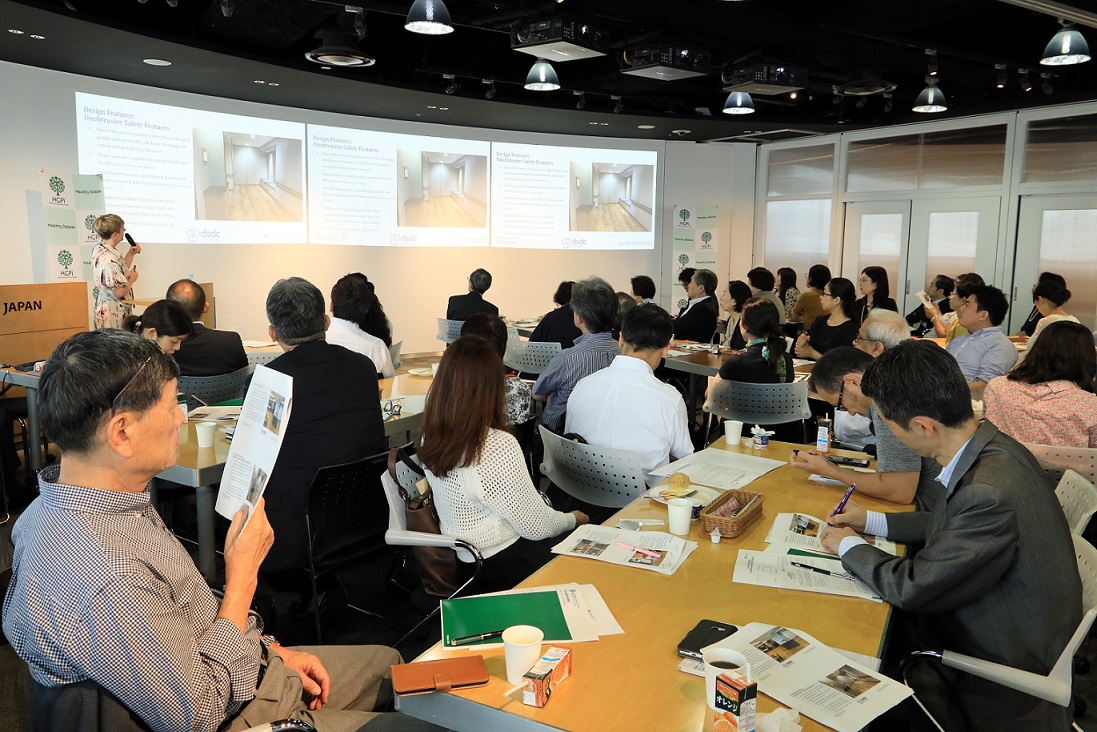[Event Report] The 81st Breakfast Meeting – A designed approach to Dementia inclusivity (October 3, 2019)
date : 12/7/2019
Tags: Dementia, HGPI Seminar
![[Event Report] The 81st Breakfast Meeting – A designed approach to Dementia inclusivity (October 3, 2019)](https://hgpi.org/en/wp-content/uploads/sites/2/060d55684f372dbaf21939ecf6cac733-2.jpg)
Longer lifespans are resulting in population aging in every country around the world with Japan leading the way. For this reason, Japan must create community-based integrated care systems to enable elderly people to continue living with peace of mind in the places to which they are most accustomed. This need is also recognized in the field of dementia and a movement to create dementia-friendly communities is advancing in every region to help those who develop dementia remain in good environments and familiar surroundings as long as possible. This type of community-building recognizes the diverse needs of people with dementia and their families. This approach is expected to effectively create dementia-friendly communities in the future.
Within this context, the changes in physical abilities such as sight, hearing, and motor skills that occur due to dementia are being analyzed to create and implement environmental designs that take these changes into account.
This effort has energized activities for creating dementia-friendly environments. In Japan, such designs have begun to be introduced at facilities for elderly people or in homes, and further research into this field and popularization of such design methods is anticipated.
For this breakfast meeting, we were pleased to welcome Ms. Lesley Palmer, Head of Design Services and Chief Architect at the University of Stirling’s Dementia Services Development Centre (DSDC). Ms. Palmer spoke about the latest research results in design for dementia-friendly environments and the field’s future prospects.
■Introducing dementia-friendly design
The dementia-friendly design aims to create products and environments that have been designed in a way that reduces the challenges to everyday living posed by dementia and makes it possible to improve quality of life (QOL) for people with dementia, their families, and their caregivers.
Researchers at the University of Stirling began studying methods for designing environments for people with dementia in 2001. Since then, they have been engaged in activities such as developing construction design methods and free smartphone applications for people with dementia and blind people and systematically reviewing literature in the field.
■The principles and goals of dementia-friendly design
While there are certain challenges to creating designs that fit the needs of all people with dementia, the principle of dementia-friendly design is to support individual needs and encourage independence. This includes designs that support everyday activities like getting ready in the morning, going to work, and using the bathroom with the aim of improving self-esteem for people with dementia. It is important to design in a way that does not cause confusion and is easy to use. For example, if a faucet handle can be easily turned by someone with dementia, it has been designed to enable easier hand washing. By popularizing such designs on the individual level and then throughout society as a whole, it will also help achieve the goal of promoting understanding and awareness of dementia.
■Activities in Japan
A project to implement dementia-friendly designs at two facilities for elderly people is currently underway. One of the facilities is located in Yokohama City.
Specifically, improvements are being made to interior design elements such as the color of the walls, furniture, and floor and to the instructions posted in each room and restroom. For example, if a mat at a building entryway is a different color than the floor around it, a person with dementia may think it is a hole in the floor. It is said that this can cause falls. To overcome this, a mat color that matches the floor is selected to avoid causing fear.
In the restroom, there have been many cases of people who had trouble using the toilet because the seat was hard to see. To help solve this issue, the toilet lid can be made a highly visible color. Doing so has resulted in examples of some people regaining their ability to use the toilet alone. Another measure is that illustrations were added to the written displays in toilet rooms and bathrooms to make the purpose of the room clear at a glance. Even though the main focus for securing people with dementia is safety, that does not take into consideration the mental and emotional effects of doing so. A person with dementia will feel anxious if they feel trapped. There are ways to keep them safe while not making them feel like prisoners. One example is changing the design of the door to replicate the wall next to it. A person with dementia will not be able to tell the door is there but workers can freely go and return without having to sneak out. This can be useful when it is necessary to create a staff-only door.
■Dementia-friendly design and the future
In the U.K., two-thirds of those with dementia cannot live at home. Furthermore, real estate prices in urban centers are high and the costs associated with long-term care are increasing. As a result, many people with dementia have had to move to facilities far from home.
Although 30 years have passed since dementia-friendly designs were first introduced in the U.K., the construction industry has only started paying attention in the last decade. Creating dementia-friendly building environments will enable people to stay in their own homes longer and contribute to improving the quality of life for people with dementia.
In addition to the design-based approach, various forms of technology are being used in the U.K. to encourage people to live in their own homes as long as possible. In the future, we hope to develop new models that can be used in the various communities in Japan and to further develop dementia-friendly designs.
A lively exchange of opinions was held at the question-and-answer session following the lecture.


(Photographed by: Kiyoshi Takahashi)
■ Profile
Ms. Lesley Palmer
Lesley Palmer is the Chief Architect at the Dementia Services Development Centre at the University of Stirling & co-founder of Iridis – a built environment digital assessment programme at the University of Stirling. Lesley is also the founding Director of INCH architecture an award-winning social enterprise architecture practice who specialize in supporting charitable organizations & economically disadvantaged communities. With 20 years of architectural professional practice, Lesley is an experienced architect and a confident leader of cross-disciplinary design teams.
Lesley leads the DSDC Dementia Design Team, which offers dementia consultancy services in architecture & design, design training and advising clients throughout their build project on the importance of and practical application of dementia design principles.
Lesley works globally supporting clients in projects in Japan, India, Australia, America, Europe, and the UK. Her fields of interest are: designing for people with dementia; demonstrating impact through good design & community benefits; and democratizing architecture.
Lesley previously held the position of Studio Director for the BSc Honors year at the Department of Architecture, University of Strathclyde, and has been a guest critic at several acclaimed schools of architecture including; Bauhaus Weimar &Glasgow School of Art.
Top Research & Recommendations Posts
- [Research Report] Perceptions, Knowledge, Actions and Perspectives of Healthcare Organizations in Japan in Relation to Climate Change and Health: A Cross-Sectional Study (November 13, 2025)
- [Research Report] The 2025 Public Opinion Survey on Healthcare in Japan (March 17, 2025)
- [Policy Recommendations] Developing a National Health and Climate Strategy for Japan (June 26, 2024)
- [Policy Recommendations] Mental Health Project: Recommendations on Three Issues in the Area of Mental Health (July 4, 2025)
- [Announcement] HGPI Endorses the “Belém Health Action Plan” (November 14, 2025)
- [Research Report] The 2023 Public Opinion Survey on Satisfaction in Healthcare in Japan and Healthcare Applications of Generative AI (January 11, 2024)
- [Publication Report] Planetary Health Promotion Project “Issues Facing Planetary Health and the Role of the Health Sector” (May 10, 2023)
- [Announcement] HGPI Joins Global Green and Healthy Hospitals (August 1, 2023)
- [Research Report] Survey of Japanese Physicians Regarding Climate Change and Health (December 3, 2023)
- [Public Comment Submission] “Interim Evaluation of the Implementation Status of the National Biodiversity Strategy 2023-2030 (Draft)” and the “7th National Report under the Convention on Biological Diversity (Draft)” (December 2, 2025)
Featured Posts
-
2025-12-11
[Event Report] Core Components of Universal Health Coverage (UHC): Achieving “Healthcare Without Financial Hardship” in Asia-Pacific and Japan (December 5, 2025)
![[Event Report] Core Components of Universal Health Coverage (UHC): Achieving “Healthcare Without Financial Hardship” in Asia-Pacific and Japan (December 5, 2025)](https://hgpi.org/en/wp-content/uploads/sites/2/HGPI_20251210_Core-Components-of-Universal-Health-CoverageUHC-top.jpg)
-
2025-12-12
[Registration Open] Meaningful Involvement Promotion Project Urgent Symposium “The New Takaichi Administration and Central Social Insurance Medical Council Reform – Ensuring Patients’ Voices are Heard” (January 22, 2026)
![[Registration Open] Meaningful Involvement Promotion Project Urgent Symposium “The New Takaichi Administration and Central Social Insurance Medical Council Reform – Ensuring Patients’ Voices are Heard” (January 22, 2026)](https://hgpi.org/en/wp-content/uploads/sites/2/HGPI_20251208_urgent-symposium-1.png)
-
2025-12-12
[Registration Open] (Webinar) The 140th HGPI Seminar “Early Detection to Reduce COPD Disease Burden: Connecting Clinical Frontiers with Health Policy” (January 27, 2026)
![[Registration Open] (Webinar) The 140th HGPI Seminar “Early Detection to Reduce COPD Disease Burden: Connecting Clinical Frontiers with Health Policy” (January 27, 2026)](https://hgpi.org/en/wp-content/uploads/sites/2/hs140-top.png)




